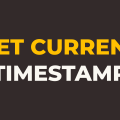How to Convert Unix Timestamp to Universal Time in Javascript
In this tutorial, you will learn how to convert Unix timestamp to universal time in javascript. Unix timestamp is the number of seconds that’s have been passed since January 1st, 1970 at UTC. UTC stands for Universal Time Coordinated. Before 1972, it was known as Greenwich Mean Time.
Unix timestamp does not change no matter where you are located in the world. This makes it easy for the computer systems to convert universal time into your local time. In javascript, we are going to use the Date constructor to convert the Unix timestamp to universal time.
The following example is pretty straightforward. We have timestamp 10999285 and we will convert it into universal time. Please have a look over the code example and steps given below.
HTML & CSS
- We have 3 elements in the HTML file (
div,button, andh1). Thedivelement is just a wrapper for the rest of the elements. - We have done some basic styling using CSS and added the link to our
style.cssstylesheet inside theheadelement. - We have also included our javascript file
script.jswith ascripttag at the bottom.
<!DOCTYPE html>
<html lang="en">
<head>
<meta charset="UTF-8">
<meta name="viewport" content="width=device-width, initial-scale=1.0">
<meta http-equiv="X-UA-Compatible" content="ie=edge">
<link rel="stylesheet" href="style.css">
<title>Document</title>
</head>
<body>
<div>
<button>Get</button>
<h1>Result</h1>
</div>
<script src="script.js"></script>
</body>
</html>
body {
text-align: center;
}
div {
display: inline-block;
}
button{
display: inline-block;
padding: 10px 20px;
}
Javascript
- We have selected 2 elements (
buttonandh1) using thedocument.querySelector()method and stored them inbtnandresultvariables. - We have created one global variable
timestampand assigned10999285as a value. - We have attached the
clickevent listener to thebuttonelement. - Inside the
clickevent handler, we are making use of theDateconstructor. We are converting the timestamp in seconds to milliseconds by multiplying it by 1000 and supplying it to theDateconstructor as a parameter. As a result, we are getting the date object which we are storing indateObjvariable. - We are using
getUTCHours(),getUTCMinutes(),getUTCSeconds()functions to get hours, minutes, and seconds of universal time. - We are using
padStart(2, 0)to make sure always 2 digits should be displayed on the screen. If we have only one digit, then we will prepend 0 to it. - We are simply creating a template string and displaying it on the screen inside the
h1element.
let btnGet = document.querySelector('button');
let result = document.querySelector('h1');
//07:21:25
let timestamp = 10999285;
btnGet.addEventListener('click', () => {
let dateObj = new Date(timestamp * 1000);
let hours = dateObj.getUTCHours().toString().padStart(2,0);
let minutes = dateObj.getUTCMinutes().toString().padStart(2,0);
let seconds = dateObj.getUTCSeconds().toString().padStart(2,0);
result.innerText = `${hours}:${minutes}:${seconds}`;
});




